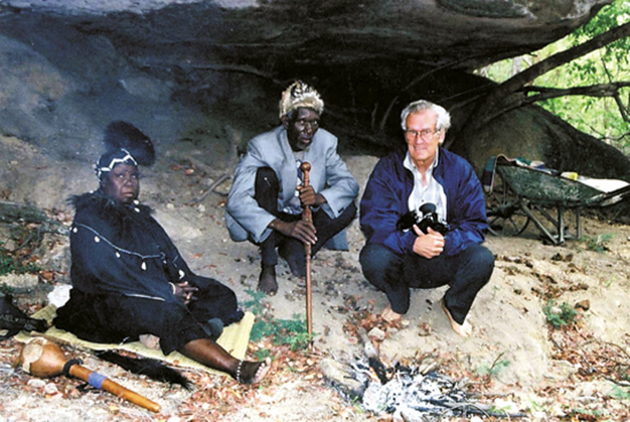RAINMAKING: AN IMPERATIVE FOR AGRICULTURALISTS AND PASTORALISTS


Chief Gwebu (in black) with an aide and Professor Marthinus Daneel, following a rain-making ceremony in Matobo in 2002
Pathisa Nyathi Review Correspondent
“ . . . the indigenous people in Zimbabwe . . . while also venerating their ancestors, looked to a powerful deity known as Mwali, or Mwari, for rain, successful crops, and the health of the land. Shrines dedicated to Mwali have been seated in the caves of the Matopos for nearly two hundred years, if not longer. The Matopos shrines dedicated to Mwali served as focal points for priests, messengers, and itinerant adepts who travelled widely, singing the messages and praises to Mwali. This deity was characterised with powerful male and female imagery, and both women and men were incorporated in the operation of the shrine system (Urban-Mead 2015:15).”
The above quotation from a book titled “The Gender of Piety: Family, Faith, and Colonial Rule in Matabeleland, Zimbabwe” by Wendy Urban-Mead encapsulates the major components of the rain-making process as still takes place annually at the Njelele Shrine in the Matobo Hills of Matabeleland South. This article, the first in a two-part series seeks to highlight the rainmaking ceremonies that take place in the Matobo District.
A meaningful rendition of the rainmaking ritual has two interrelated components, namely the material and spiritual components. This is in line with the African worldview or cosmology as expressed through their spirituality. The rainmaking ritual brings to the fore the interplay between nature, culture and spirituality. At the centre of the annual rituals is Mwali or Mwari the Deity who is thought to reside at Njelele, a hierarchy of his rain priests and related dances called wosana. The priests or messengers of Mwali are also called amawosana or manyusa.
The timing of the rain making rituals is determined by the natural rhythm of the seasons or seasonality or periodicity of summer, autumn, winter and spring. Every September the Njelele Shrine is open to spiritual pilgrims coming from various parts of Zimbabwe and beyond. A month earlier the shrine would have been cleansed when the resident shrine adept with a few assistants goes up to the mountain cave to spruce up the site in readiness for the impending pilgrimage. This happens to coincide with similar rituals at community level when the people within the catchment areas also cleanse the land.
According to the beliefs of the Africans, rainfall may be inhibited by the status of the land. There are conditions that are thought to militate against the development of rain clouds. Trees that were struck by lightning in the previous rain season are one such inhibiting condition. Bird nests on trees must be removed together with nestlings of certain birds which when they open their mouths are thought to drive away developing rain clouds.
Men gather at a designated place to undertake a cleansing hunt called tenela in Tjikalanga. The men, with the assistance of their dogs, go on a hunt and kill any animal that they come across. They will also scour the mountains where they target lurking klipspringers and other mountain-dwelling animals. When an animal is killed the elderly men take it back to base. The hunting party is away for nearly the duration of the day. At the end of the day the party returns to base, usually a place that has a pool of water.
Meanwhile, the women perform their own ritual to cleanse the land. The women used to go bare-breasted, beating drums in their wandering through the land. At my home place, Sankonjana, this ritual has died away largely due to the advent of Pentecostal Christianity. The women did not want men to come into their view. In the event that an unfortunate man was overtaken by the women he was expected to lie on the ground facing down till the women had passed.
As the women moved around they sang rain songs. Finally, the women went to a meeting place and were given a portion of the meat from the animals that the men folk killed. Salt is never used to season the meat. When the meat has been consumed all the bones are gathered together with the skins and burnt. Thick smoke billows up and the scent from burning bones and skins pleases Mwali. The resulting ash is then deposited in water the pool.
When cultural practices are being described it is important that the philosophical underpinnings or underlying thought are given. This is important for a fuller understanding of the cosmology that underpins the cultural practices. The assumption here is that behind every cultural practice there is some underlying belief or beliefs that serve as the pillars that support the cultural practice. When the pillars collapse the cultural practice comes tumbling down. When the pillars crumble things begin to fall apart. It is imperative therefore that as we render an account of cultural practices we go beyond and offer the cosmological underpinnings or simple terms the justifying beliefs.
For the Africans there is a thin line separating the sacred and the profane. Equally there is a very thin line between the physical/material and the spiritual. Everything material has a spiritual dimension which to the traditional African was a greater reality. When something goes wrong in the spiritual realm there are repercussions in the material domain. The rain, a material reality is brought about through spiritual intervention. Where a veld is materially unclean that has a negative bearing on the possibility of the rain developing. It is this interrelatedness that has to be appreciated when dealing with the traditional African and his cultural past and practices.
In the articles on African spirituality it will be imperative to bring out the intangible cultural components accompanying the cultural practices. Before we delve into the intricacies of rainmaking and in particular the symbolic manipulation inherent in the rituals we need some brief background on the people behind the Mwali religion and its related rain shrines. The role of the spiritual realm or African spirituality as the repository of the African past has been underestimated, despised and denigrated. For a non-literate society spirituality took over the role of literacy. When we give a rendition of the praises of Mwali it will become apparent what past resides in spirituality.
Rain making was a characteristic feature of all African societies. There were differences though in how the rituals were conducted. However, in all of them there was a clear link between the spiritual and material dimensions. Symbolic manipulations were also evident. The people of interest to us are what we term the generic Bakalanga who arrived in this part of the world over two thousand years ago. In this category we include the following, inter alia: Balilima, Batalawaunda, Bajawunda, Banambya, Balozi, Balozwi/rozvi, Bahwamamba, Batavatsindi, Balembethu, Vhavenda, Bakalanga, Bawumbe, Bakaranga, Bandau, Bamanyika, Bazezuru and Bakorekore. There are others who are of the same ethnic stock but migrated further south and got Sothoised and are today found in South Africa and Botswana: Babirwa, Bapedi, Bakgatla, Batswapong, Barolong, Balobedu and Bahurutshe, among others.
These were an Iron Age people who practised crop agriculture. Small grains such as sorghum (mapfunde), finger millet (rapoko) and pearl millet (zembgwe) were grown. They were also pastoralists who kept animals such as cattle, goats and sheep. At the same time these were the people who established the Zimbabwe type settlements with stone walls, maswingo (singular, luswingo). The best known of these was Nzi wa mabgwe (the village of stones) now called Zimbabwe. Clearly such people needed rains for agriculture and general sustenance. For them rain making was critical for their survival. Fertility of the land and, by extension, that of the people, was imperative and for that rain was critical hence the spiritual measures that were taken in the form of rituals that were resorted to.
The generic Bakalanga or Banyai were not the original inhabitants of the land. This becomes apparent in their rain rituals, in particular the praises that they shower on Mwali/Mwari. An earlier group, the Dziva-Hungwe had stronger connections with the art and skill of rainmaking. Their name as Hungwe-Dziva suggests water. The hungwe bird is associated with water. Dziva is a pool, obviously of water. Dzivaguru is a well known rain spirit medium in the land of the Batavara, an ethnic group belonging to the broader Hungwe-Dziva people (Ngwenya/Ngwena, Mvubu, Save, Siziba, Nyoni, Hove, Shiri and many others).
The next article will deal more specifically with the conduct of the rain making ritual and its processes in particular the symbolic manipulation of rain deriving from the underpinning African thought and cosmology.










Comments